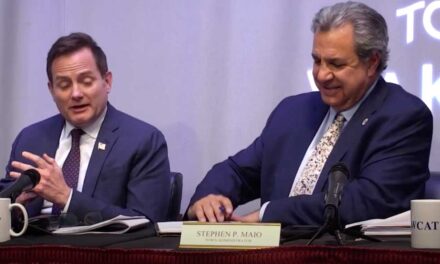Published in the June 27, 2017 edition.
By MARK SARDELLA
WAKEFIELD – As part of its ongoing downtown revitalization efforts, the town got a grant in 2016 from the Metropolitan Area Planning Council (MAPC) to look at ways to turn Albion Street (from Main Street to North Avenue) into a thriving arts and culture destination. Last night, the Board of Selectmen got a look at the results of that study.
Amanda Chisholm of the MAPC and Town Planner Paul Reavis appeared before the board to discuss the Albion Arts Corridor Economic Development Strategy, a 92-page report produced by the MAPC.
Reavis noted that Albion Street already has seven arts-related businesses as well as the new Albion Cultural Exchange in the former Light Department building at 9 Albion St. He explained that the grant meant that the town essentially got a team of planners from MAPC to work with the town to develop plans to help Wakefield achieve its goal of expanding Albion Street into a thriving arts and cultural destination. That team of five MAPC planners was headed by Chisholm, MAPC’s Chief Economic Development Planner.
Chisholm said that MAPC’s work included a review of the town’s assets, extensive feedback from the community and an overview of the economic development benefits of increasing arts and cultural opportunities in the downtown area. She noted that Wakefield has over 40 core creative businesses and about 20 different arts and culture organizations.
Based on community feedback, part of MAPC’s recommendation was to find ways to coordinate those businesses and organizations.
“People wanted a more cohesive cultural identity,” Chisholm said.
MAPC gathered feedback through focus groups with local artists, online surveys and public forums over the past year.
Chisholm said that some of what residents said they wanted to see more of included more permanent spaces for art to be displayed, more venues for performance and creating more permanent spaces for artist lofts. MAPC also heard that more general issues in the downtown needed to be addressed in order to draw more people in, such as parking, more engaged landlords, along with better lighting and signage.
Chisholm stressed that there is great potential for leveraging arts and culture for economic development. The MAPC report cites studies that have shown that people who seek out arts and cultural experiences are likely to stay longer at their destination and spend money on items such as meals, retail purchases, transportation, childcare and parking.
She noted that there is currently high demand in the region for artist studio space, classes and cultural events. Wakefield is well-poised to meet some of this demand, she maintained. The ACE Center building could serve as gallery space, offering the community better access to art and culture while giving exposure to artists who can showcase and sell their work. The upper levels of the building could eventually serve as loft space, she said.
Chisholm discussed the MAPC’s recommendations for renovations and managing the ACE Center building for optimum benefit. The town should hire a Cultural Affairs Coordinator, she said, to work with the ACE Committee to continue programming and evolve the building through renovations. The coordinator would also develop an annual strategy to leverage arts and culture for economic development and work with an Arts and Culture Economic Council.
Chisholm said that MAPC staff reviewed zoning along Albion Street and recommended creating either an Arts and Culture Overlay District or changing the underlying zoning to an arts and culture district.
Chisholm summarized MAPC’s recommendations, which she said were organized around five major goals:
• Creating a distinct arts and cultural identity for downtown and the Albion Arts Corridor.
• Transforming Albion Street into an active street and focal point for arts and culture.
• Redeveloping the Albion Cultural Exchange Building into a permanent arts and culture center.
• Marketing arts and culture in the downtown.
• Encouraging zoning and redeveloping to support and grow a thriving arts and culture district downtown.
The MAPC report closes with the following conclusion:
“Downtown Wakefield has great potential to become a thriving arts and culture destination. The key will be a collaborative process that involves various stakeholders and groups currently working on initiatives in the downtown. If undertaken in a coordinated and organized way, strategies that support Wakefield’s creative economy, create and market a distinct arts and cultural identity for the downtown, position the Albion Cultural Exchange Building as an anchor institution for arts and culture and encourage redevelopment supportive of the arts can yield great success.”
The full text of the MAPC’s Albion Arts Corridor Cultural Economic Development Strategy is on the town’s web site under “Town News” or at the following direct link: https://www.wakefield.ma.us/sites/wakefieldma/files/file/file/wakefield-6-23-2017-prefinal.pdf.




